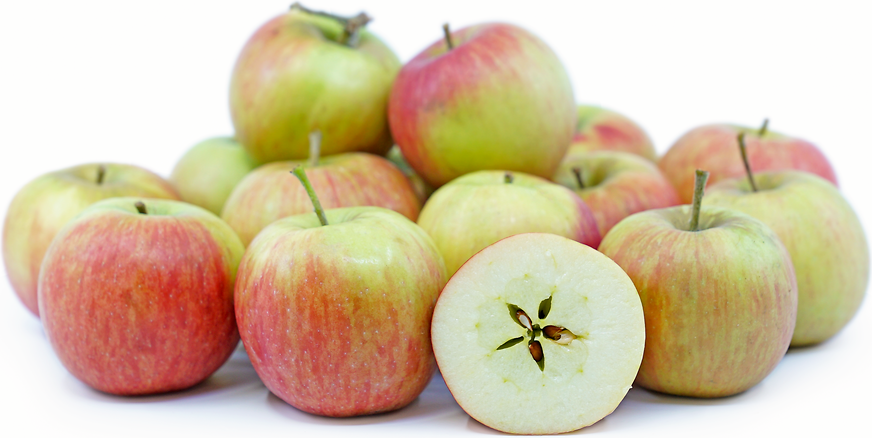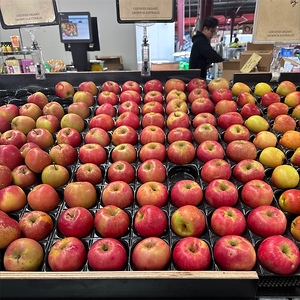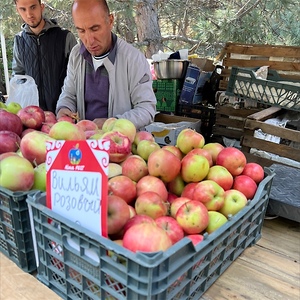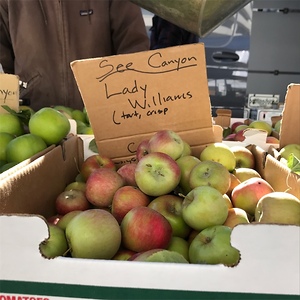


Lady Williams Apples
Estimated Inventory, lb : 0
Description/Taste
Lady Williams apples are moderately sized, round to conical fruits with a uniform appearance. The skin is semi-thin, smooth, and matte with a yellow-green base, covered in red-pink blushing and striping. Underneath the delicate surface, the flesh is ivory to white, crisp, aqueous, and firm, encasing a central core filled with small, black-brown seeds. Lady Williams apples have an initially tart flavor when harvested young, but when left to fully mature, the flesh develops a balanced, sweet and tangy taste.
Seasons/Availability
Lady Williams apples are available in the late winter through summer.
Current Facts
Lady Williams apples, botanically classified as Malus domestica, are a late-season variety that belongs to the Rosaceae family. The sweet-tart fruits were first discovered as a chance seedling growing on a farm in Australia and were named after one of its founders, Maude Williams. Rumor has it that the children who lived next door to Williams were unsure of the proper way to address her when visiting her property and decided to refer to her as “Lady Williams.” Over time, the nickname became a normal title for Williams and was given to the new apple variety in memory of her beloved name. Lady Williams apples are considered a versatile variety, consumed both fresh and utilized in culinary applications, and are valued by growers for their extended storage capabilities. In the present day, the variety is primarily localized to Western Australia, and outside of the country, it is considered a rare, specialty variety grown by specialty farms and apple enthusiasts.
Nutritional Value
Lady Williams apples are a good source of vitamin C, which is an antioxidant that protects the body against external aggressors, increases collagen production, and boosts the immune system. The fruits also contain potassium, boron, fiber, phosphorus, and calcium.
Applications
Lady Williams apples are a versatile apple that can be utilized in both raw and cooked applications such as baking, boiling, and poaching. When fresh, the apples can be eaten out-of-hand to showcase the balanced, sweet-tart flavor, or they can be sliced and tossed into green salads, grated into coleslaws, quartered and served on appetizer plates with dips and spreads, or layered into sandwiches for a crisp bite. Lady Williams apples can also be pressed into ciders and juice, baked into turnovers, pies, crumbles, and crisps, blended into applesauce, minced into sausage and burger patties, or poached in wine as a sweet and tangy dessert. Lady Williams apples pair well with cheeses such as brie, gruyere, parmesan, cheddar, and swiss, fennel, cabbage, herbs such as basil, rosemary, sage, thyme, and mint, oranges, coconut, meats such as pork, poultry, beef, and fish, and spices such as nutmeg, allspice, pumpkin spice, and cinnamon. The fresh fruits will keep 3-4 months when stored whole and unwashed in a cool and dark place such as the refrigerator.
Ethnic/Cultural Info
In Australia, Lady Williams apples are credited as one of the parent varieties of the cripps pink or pink lady apple. It is believed that the Lady Williams apple gave the new fruit its famous pink-hue, and after its release, pink lady apples became a popular variety exported and grown around the world. Lady Williams apples are also a parent variety to the sundowner apple, and both the pink lady and sundowner varieties were the first two cultivars created by the Western Australia Breeding Program. With widespread global recognition for the new varieties created, the breeding program quickly became one of the most successful research centers in Australia, and much of the program’s success was based on the Lady Williams apple’s genetic contributions.
Geography/History
Lady Williams apples were discovered as a chance seedling that sprouted on Arthur and Maude William’s farm in Donnybrook, Australia, in the 1930s. The apple tree first grew beside the William’s house, and though believed to be a descendant of the jonathan or granny smith apple, the origins of the apple are still mostly unknown. In the 1940s, Lady Williams apples were given as gifts to the surrounding community, and with increased demand and popularity over time, the variety was cultivated and released to commercial markets in the late 1960s. Today Lady Williams apples are primarily grown in Western Australia through local farms. The variety is also found on a smaller scale in home gardens and through farmer’s markets in the United States, Europe, and Southeast Asia.










